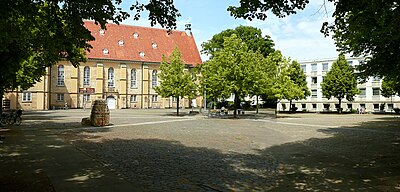Neustädter Markt (Hanover)

The Neustädter Markt in Hanover is a square in the Calenberger Neustadt district . It is bounded in the north by the Neustädter Church and at its southwestern tip by Calenberger Strasse and the Rote Reihe . The square was the urban center and the much-used marketplace of the formerly independent new town . Until the main train station was built in the middle of the 19th century, the focus of the hotel industry and purveyors to the court was here .
history
Emergence

After the Duke of Braunschweig-Lüneburg , Georg , declared Hanover to be his residence in 1636 during the Thirty Years' War (so-called " Residenzrezess "), the Neustadt was expanded to make room for the Duke's court and official state.
In 1671 the Neustadt received the market privilege . The space for the market was to be created directly on " Steinweg " (later Calenberger Strasse ), the connecting route between the old and new towns. For this purpose, the Jewish pond was first filled in. In 1678 at the latest, the first square was built under the direction of the businessman Johann Duve .
At the instigation of Duke Johann Friedrich , under the direction of Johann Duve and based on a model delivered by Hieronymo Sartorio in 1671, the Parnassbrunnen on the Neustädter Markt was built.
For the nearby residence in Hanover's old town, the Neustädter Markt developed into the focus of the hotel industry and purveyors to the court.
In 1746 the first Neustadt town hall was built on the western edge of the square. After a new town hall had been built in Bäckerstraße in 1777, the old building was first used as a "Neue Schenke", later as a "British Hotel" and finally as a consistory (destroyed in 1943, today the Evangelical Lutheran Church of Hanover ).
The most striking building on the square was the Neustädter Hof- und Stadtkirche St. Johannis , built in 1666–70 .
By Johann Duve was after 1671 as the first major decorative element of the square, the Parnassus Fountain installed (1802 canceled): He was as a grotto with figure trim created by the artist Girolamo Sartorio , M. Riggus and Marinus Cadart , also in the construction of the grotto and the cascade in the Great Garden . He was supposed to supply the Neustadt with fresh well water. Double pipes led the water here from a basin in the Linden kitchen garden. The fountain should represent the Parnassus , the mountain of the muses.
In 1783, the market offers were redistributed: the space reserved primarily for food was initially paved with pebbles.
In 1828 a new fountain was installed on Neustädter Markt in an octagonal basin as a goblet on a pedestal (today with a modified goblet: Schlossbrunnen on Hannah-Arendt-Platz ). It was placed in front of the Oberrealschule am Clevertor in 1914 to clear the space for the Duve fountain (also known as the sower fountain , since 1953 on Leibnizufer ), which Georg Herting did not install until 1916 .
After 1945
After the heavy destruction in the Second World War , the square was expanded according to a construction plan to the footpath in front of the church apse, which established the connection from the Rosmarinhof to the old town. However, plans to continue the route over a bridge in the direction of Kramerstraße were not carried out, as was the reconstruction of the consistory.
In 1969/70 the square was redesigned. Among other things, the old paving was structured by a radial structure made of basalt.
In 1974 the "table fountain" ( Neustädter-Markt-Brunnen ), donated on a private initiative and created by Max Sauk , was installed in the center of a large plaster basin.
In 1985 a tree ring around the fountain and horseshoe-shaped lime trees were planted around the nave.
The "wish stone" by W. Behre was set up in 1996 on the western edge of the square.
The forecourt west of the church tower was enlarged in 2002 with funds from the "Stadtplatzprogramm", while the Neustädter Markt east of the square was provided with a raised lawn bed and a horseshoe-shaped row of benches. In addition, the square was equipped with movable individual chairs.
literature
- Helmut Knocke , Hugo Thielen : Hannover Art and Culture Lexicon , Handbook and City Guide , 4th edition, Springe, 2007, p. 173
- Aufbaugemeinschaft Hannover eV (Ed.): Stadtmitte Hannover , 1949
- F. Eggerling: Urban planning in Hanover. In: Bauen und Wohnen 1956 , Hannover 10, p. 327ff
- W. Kleffner: The city map of Hanover and its development. In: Yearbook of the Geographical Society of Hanover for 1940 and 1941, 1942 , p. 207 and plate 55
- Eva Benz-Rababah : Neustädter Markt. In: Klaus Mlynek, Waldemar R. Röhrbein (eds.) U. a .: City Lexicon Hanover . From the beginning to the present. Schlütersche, Hannover 2009, ISBN 978-3-89993-662-9 , p. 468f.
Web links
Individual evidence
- ^ Rainer Ertel : Parnassus fountain. In: Stadtlexikon Hannover , p. 495
- ^ R. Hartmann : History of Hanover from the oldest times to the present ; Volume 1, p. 410
Coordinates: 52 ° 22 ′ 15.1 ″ N , 9 ° 43 ′ 43.6 ″ E

